"Lee Mingwei and His Relations: The Art of Participation - Seeing, Conversing, Gift-giving, Writing, Dining and Getting Connected to the World" is a solo exhibition by Taiwan-born artist Lee Mingwei. In their discussion, curator of the exhibition Kataoka Mami asks Lee to explain just how the works he "exhibits" differ from the way we engage with art at most exhibitions.
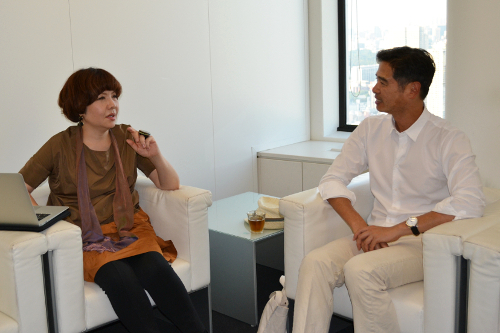
Kataoka Mami (left) and Lee Mingwei (right)
Kataoka Mami (hereafter Kataoka) : Visitors to your exhibitions don't just "look at art"; many of the works are characterized by the way they prompt the visitor to "do something." Some even get people outside of the museum involved. Among the key elements of these works are the ideas of exchange, gift-giving, and intimacy. There are elements that also make us ponder the relation of money to art.
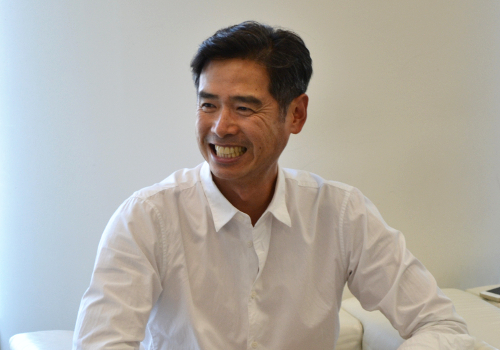
Lee Mingwei
Lee Mingwei (hereafter Lee) : Money for Art(*) is a good example. What I did for this project was fold a ten-dollar bill, origami-style, to form an abstract object small enough to sit on the palm of your hand. So it was a like a tiny sculpture made from a ten-dollar bill. I made nine of them, and then asked people I happened to meet in a café if they would like to have one in exchange for telling me their phone number. Upon calling them six months and again a year later, I learned that some had dismantled the piece and used it as a ten-dollar bill, and others had kept it intact.
So while it seems like a simple project, it actually has some very complex elements. Is this piece of "origami" art? Or is it currency?
The most memorable participant was a man who was homeless, although you couldn't tell from the way he looked - clean clothes, always carrying a thick book he was reading, and now the proud owner of 14 of these objects. Dismantled: 140 dollars. But he hasn't unfolded them and used the money. He keeps them intact, and is extremely proud to own the artworks.
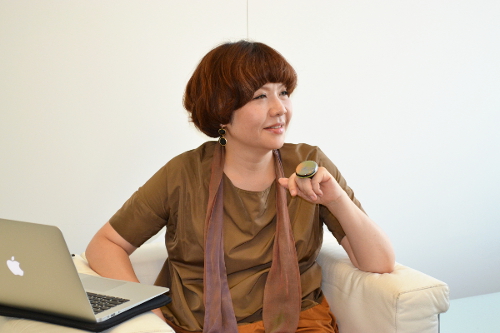
Kataoka Mami
Kataoka: Stone Journey, which appears in the exhibition at Mori Art Museum, is interesting in a similar way. You had 11 stones you picked up in New Zealand replicated when you returned to Taiwan, creating 11 sets of pairs.
Lee: Whoever purchases this work has to decide at some point which one of the two stones to discard. The stones I picked up are products of nature with a 70-million-year history; the replicas I made in Taiwan are fabricated. So the work questions the notions of ownership, and of value. Which stone is more precious, the natural stone I picked up, or the artificial stone I made? And by discarding one of the stones, will the piece the collector paid no small sum for be destroyed? Or is it the start of another "stone journey"? Destruction leading to creation. At this point, none of the collectors have thrown either stone away yet. So it will be very interesting to see when it happens.
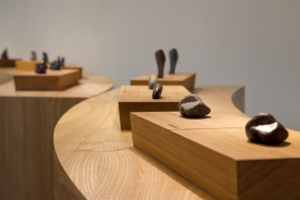
Stone Journey
2012
Installation view: "Tales of Flower and Stones," Espace Louis Vuitton, Taipei, 2012
Photo: Lee Studio
Kataoka: Your kite work, Nu Wa Project, is another intriguing piece that explores of the idea of "exchange." Here a person buys the artwork, but cannot keep it.
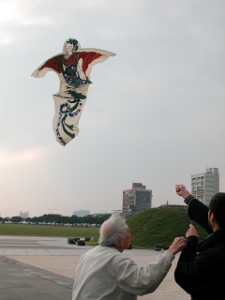
Nu Wa Project
2005
Photo: Lee Studio
Lee: The piece is based on a Chinese and Taiwanese folktale about the goddess Nüwa who sacrifices herself to patch a hole in the sky and save her children - her children being all of us. For this project I created a kite, asking the owner to let it fly very high, and then cut the string, so that Nüwa can patch the hole in the sky. So in this case the owner has lost the object itself, however in letting Nüwa patch the hole, and save the world, the emotion is very full and rich inside. This is another work that deals with the dilemma of owning something physically, and owning something emotionally.
Kataoka: With your projects, the collector exchanges money to get the object in the same way they'd purchase any other artwork, but in the end they have to release the object, so that they only keep a special memory.
Lee: Owning art generally involves possessing an object such as a painting or sculpture. But with my art, they keep the spirit or essence of what that object is.
* Money for Art is not shown in this exhibition.
Original Text (in Japanese-language): Aono Naoko (Editor/writer)
Translation: Miki Pamela
Issue 68 of HILLS LIFE, the latest issue of the area magazine packed with info from street news to trends all to make life at the Roppongi Hills more fun, features a related conversation between Lee Mingwei and Kataoka Mami. Don't miss it!
Read the PDF edition (in Japanese) here
■Related links
・Dialogue between Lee Mingwei and Kataoka Mami
(1) What is "Participatory Art"?
(2) When "Gift-giving" Becomes Art
(3) Art Enriched by How We Participate
・"Lee Mingwei and His Relations: The Art of Participation: Seeing, Conversing, Gift-giving, Writing, Dining and Getting Connected to the World"
Saturday, September 20, 2014 - Sunday, January 4, 2015
・"MAM Project 022: Jacob Kirkegaard"
Saturday, September 20, 2014 - Sunday, January 4, 2015








